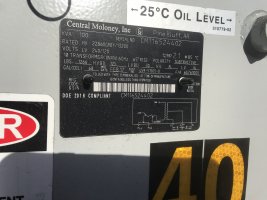-
Welcome to The Building Code Forum
Your premier resource for building code knowledge.
This forum remains free to the public thanks to the generous support of our Sawhorse Members and Corporate Sponsors. Their contributions help keep this community thriving and accessible.
Want enhanced access to expert discussions and exclusive features? Learn more about the benefits here.
Ready to upgrade? Log in and upgrade now.
You are using an out of date browser. It may not display this or other websites correctly.
You should upgrade or use an alternative browser.
You should upgrade or use an alternative browser.
Utility Transformer Fault Current
- Thread starter jar546
- Start date
chris kennedy
ADMIN
We can tell you fault current at tranny secondary bushings but for the service disconnect need to know wire size and length between the two.
I’m pretty sure that “we” Is a party of two.We can tell you fault current at tranny secondary bushings but for the service disconnect need to know wire size and length between the two.
Last edited:
jar546
CBO
We can tell you fault current at tranny secondary bushings but for the service disconnect need to know wire size and length between the two.
You ruin everything with trick questions!
So after we figure the fault current at the secondary taps, what is it at the service disconnect if the run is parallel (2) 350's @ 50'?
jar546
CBO
I’m pretty sure that “we” Is a party of two.
Lots of commercial electrical inspectors know and should know how to do this since it is part of plan review.
Jeff,
Maybe one in a hundred commercial electrical inspectors have the knowledge that you do. It's not that it is so complicated but rather that they have not been exposed to the formula. I for one would never need to know. Not that it would never come up during an inspection but because I ask for the number and run it by my electrical engineer.
So be a Peach and tell us how to do it.
Thanks in advance
Maybe one in a hundred commercial electrical inspectors have the knowledge that you do. It's not that it is so complicated but rather that they have not been exposed to the formula. I for one would never need to know. Not that it would never come up during an inspection but because I ask for the number and run it by my electrical engineer.
So be a Peach and tell us how to do it.
Thanks in advance
jar546
CBO
Jeff,
Maybe one in a hundred commercial electrical inspectors have the knowledge that you do. It's not that it is so complicated but rather that they have not been exposed to the formula. I for one would never need to know. Not that it would never come up during an inspection but because I ask for the number and run it by my electrical engineer.
So be a Peach and tell us how to do it.
Thanks in advance
This is actually somewhat of a repeat: https://www.thebuildingcodeforum.com/forum/threads/calculating-fault-current.24172/
Well there's no phone number on this label so I can't be much help here.This is actually somewhat of a repeat: https://www.thebuildingcodeforum.com/forum/threads/calculating-fault-current.24172/
steveray
SAWHORSE
110.24.....But that is as far as I go, make the engineer do the calcs...
jar546
CBO
There isn't always an engineer needed for every transformer swap, or electrical job.
My jurisdiction has combination inspectors. We are tasked with all of the codes. I know enough to ask when I know that I don't know.There isn't always an engineer needed for every transformer swap, or electrical job.
None of us are supposed to inspect a transformer that was not plan checked by our electrical engineers. We seldom see a transformer installation. It takes the burden from the inspector....an inspector that has plenty to do.....an inspector that just came from a re-roof inspection and has new house, framing and all of the roughs, up next. Add to that the experience level that abounds here and ....well thank goodness that we have the engineers.
jar546
CBO
My jurisdiction has combination inspectors. We are tasked with all of the codes. I know enough to ask when I know that I don't know.
None of us are supposed to inspect a transformer that was not plan checked by our electrical engineers. We seldom see a transformer installation. It takes the burden from the inspector....an inspector that has plenty to do.....an inspector that just came from a re-roof inspection and has new house, framing and all of the roughs, up next. Add to that the experience level that abounds here and ....well thank goodness that we have the engineers.
Most inspection departments/agencies do not have the luxury of an in house engineer. I guess you are lucky.
We have all kinds..... in the dozens. If it was left up to the administration, there wouldn't be anything but engineers.Most inspection departments/agencies do not have the luxury of an in house engineer. I guess you are lucky.
Last edited:
steveray
SAWHORSE
Then if the electrician wants to show me his calcs, I would be happy to review them....There isn't always an engineer needed for every transformer swap, or electrical job.

